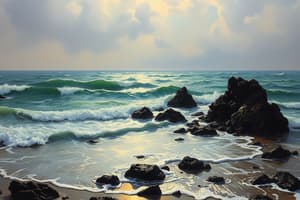Podcast
Questions and Answers
What are tides?
What are tides?
- Seasonal changes in the level of ocean water
- Daily changes in the level of ocean water (correct)
- Monthly changes in the level of ocean water
- Constant levels of ocean water
What is a Spring Tide?
What is a Spring Tide?
The highest high tide occurs during this tide when the Sun, Earth, and Moon are in a straight line.
What is a Neap Tide?
What is a Neap Tide?
A tide with the least difference between high and low tide when the Sun, Earth, and Moon are at a ninety-degree angle.
What causes a Spring Tide to occur?
What causes a Spring Tide to occur?
What causes a Neap Tide to occur?
What causes a Neap Tide to occur?
The moon's ______________________ ________ creates the Earth's tides.
The moon's ______________________ ________ creates the Earth's tides.
Earth completes a rotation on its axis every _____
Earth completes a rotation on its axis every _____
What is a High Tide?
What is a High Tide?
What is a Low Tide?
What is a Low Tide?
How often do Spring Tides occur?
How often do Spring Tides occur?
How long does it take for a low tide to become a high tide?
How long does it take for a low tide to become a high tide?
What is Gravity?
What is Gravity?
What is the time it takes from one high tide to the next?
What is the time it takes from one high tide to the next?
What is Tidal Range?
What is Tidal Range?
Flashcards are hidden until you start studying
Study Notes
Tides Overview
- Tides represent daily fluctuations in ocean water levels, influenced by gravitational forces.
Spring Tide
- Spring tides result in the highest high tides, occurring when the Earth, Moon, and Sun align in a straight line.
Neap Tide
- Neap tides exhibit the smallest difference between high and low tides, caused when the Sun, Earth, and Moon form a right angle (ninety degrees).
Influence of Lunar Phases
- Full and New Moons trigger spring tides due to their alignment.
- The 1st and 3rd Quarter Moons are responsible for neap tides.
Gravitational Forces
- The Moon's gravitational pull is crucial for creating Earth's tides.
Earth's Rotation
- Earth rotates on its axis approximately every 24 hours.
High and Low Tides
- High tide occurs when water levels rise above the average sea level.
- Low tide occurs when water levels drop below the average sea level.
Tidal Frequency
- Spring tides occur every 14 days, coinciding with the lunar cycle.
- The transition from low tide to high tide averages about 6 hours and 12.5 minutes.
Time Intervals
- The duration from one high tide to the next typically exceeds 12 hours.
Tidal Range
- The tidal range refers to the difference in height between the lowest and highest tides.
Studying That Suits You
Use AI to generate personalized quizzes and flashcards to suit your learning preferences.




